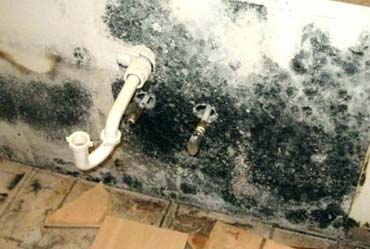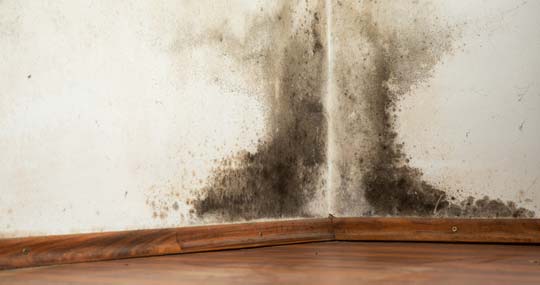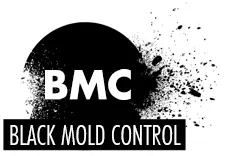What causes black mold? When it comes to black mold, prevention is definitely better than trying to find a cure. This type of mold can cause a wide variety of health issues and is difficult and expensive to remove, but it also requires some pretty specific conditions in order to grow. If you understand the causes of black mold, you may be able to prevent these conditions and avoid the problems associated with black mold growth.

What does black mold need to grow?
In order for black mold to develop, particular elements must be present. These include:
Mold spores
Like all mold, black mold growth begin as spores. These spores move through the air and settle on walls, ceilings and other surfaces. When the proper conditions are present, the mold growth begins. Mold spores are present everywhere and can survive even the most extreme circumstances, so it is nearly impossible to prevent them from getting into your home.
A food source
Black mold can eat almost anything that contains organic material, but it prefers substances with high amounts of cellulose and processed cellulose in particular. Paper is its favorite food, but it can also grow well on wood, cardboard, particleboard, straw and drywall. In fact, even lint and dust can contain cellulose and be a sufficient food source for black mould.
A place to grow
Fungi can grow on any surface that contains an adequate supply of food. This can include furniture, clothes, books, carpet, tile, ceilings and walls, just to name a few locations. Basements and crawl spaces are also common places for black mould growth due to their generally high moisture content and common lack of maintenance.
Oxygen
Fungi require oxygen in order to grow. Unfortunately, however, you can not kill the fungi by simply depriving it of this substance. They can survive in a dormant state without any air at all for millions of years. Once the proper conditions are again present, the growth will resume.
A source of moisture
Of the elements necessary for black mold growth, moisture is the most important. Black mold requires more water than any other type of mould, and it needs it for longer periods of time. It can receive this moisture from a wide variety of sources, including rain, leaky pipes, humidity in the air and condensation from things such as air conditioners or dryer vents.
Perfect conditions for black mold growth
Black mold can grow any time there are spores, food, oxygen and moisture; however, there are certain conditions that can increase its growth more than others. It thrives when there is:
- Adequate Heat – Fungi can survive in a wide range of temperatures, but it grows best when it is warm. The ideal temperature for this type of mould growth is about 73 degrees Fahrenheit, but it can occur in temperatures as low as 36 degrees Fahrenheit or as high as 104 degrees Fahrenheit. In addition, black mould can lie dormant in temperatures outside this range.
- Enough Humidity – In general, mould growth can occur any time the relative humidity is higher than 55 percent. Black mold, however, usually demands more extreme conditions; it normally can not germinate unless it has either standing water or a relative humidity of at least 90 percent. It doesn’t need as much moisture once the growth process has begun, but it still needs a relative humidity of 70 percent or more to flourish.
- Sufficient Time – Most molds can begin to grow after being in contact with water for 24 to 48 hours, but black mildew requires longer exposure times. A substance must be very wet for several days before this type of mold can start to develop. This commonly occurs in the case of a flood or a leak.
- Minimal Light – It does not need light in order to grow. It can spread in complete darkness and may even prefer those conditions at times. For the most part, however, it grows best when there are small amounts of light. Large quantities of light, and ultraviolet light in particular, can kill black mold.
How long does it take for black mold to grow?
In many ways, black mold acts in the same manner as other microbes. From the moment that spores strike a solid habitat, moldy conditions might appear between 24 and 48 hours later. Black varieties tend to have a slower colonization process after that. It might take up to 12 days for a real patch of microbes to flourish.
These time frames are based on suitable conditions and certain causes being present. If an area dries out, the microbes cannot grow as readily as they would with the moisture in place.

What causes black mold in your home?
There are many situations that can contribute to a black mold problem in your home. For example:
Leaks
Any time something in your home is leaking, you have the potential for enough moisture to accumulate that black mold can grow. Unfortunately, many leaks go undetected for long periods of time because they are very minor or are in an area that is hidden from view. By the time you realize you have a leak, it is too late. The most common places for leaks to occur include pipes, roofs, air conditioners, washing machines and toilets.
Poor ventilation
Most modern homes and apartments are very tightly sealed. This makes them easy to heat and cool, but it can also cause them to be poorly ventilated. Poor ventilation makes it difficult for humidity to escape from the home, causing moisture to accumulate on ceilings, walls and other surfaces. The lack of airflow also means that wet areas take a long time to dry, which gives black mold plenty of time to develop.
Flooding
Floods are one of the most common causes of black mold. They soak entire areas of a home, and the water can seep deeply into walls, ceilings, and flooring materials. These surfaces can sometimes take several weeks to completely dry out. Therefore, it is almost inevitable that some form of mold will implant itself in your home after a flood, and it is very likely that at least some of it will be black mold.
Lack of maintenance
The best way to prevent black mold is to find and quickly repair problems that occur in the home’s windows, roof, heating and cooling system, and plumbing. Regrettably, many homeowners do not take the time to maintain these areas or to check for proper ventilation and humidity levels. This can contribute to black mold.
Humidifiers
Not only do humidifiers increase the moisture inside a home, but they can also be a place for mold to grow and a way to distribute it throughout the house. The best way to avoid this problem is to use a humidifier with a relative humidity sensor and to clean the humidifier with an antimicrobial solution on a regular basis.
Condensation
When warm air meets a cold surface, condensation can develop. This commonly occurs on pipes, air conditioners and walls, and these can become places for mold to grow. Condensation can also accumulate on concrete, even if it is covered by carpet.
Blocked gutters
When a home’s gutters are blocked, rainwater can not escape. If the problem is not discovered and repaired, the water will build up in the gutters and seep into the home through the walls or the roof or accumulate at the foundation, creating the perfect environment for black mold.
Wet clothes
Some people dry their clothes on indoor clotheslines or leave damp clothes in a pile on the floor. This releases moisture into the air and can quickly raise the humidity level if there is not adequate ventilation. In addition, it can create wet surfaces where black mold can flourish.
These are only a few of the most common black mold causes, but if you keep an eye out for them you can prevent black mold cases. This may seem hard, but it is much better than trying to fix the problem once it has occurred.
How to prevent black mold to grow?
There are several ways that you can control these growths in your home. You must control the amount of moisture in the home in the first place. Add fans and ventilators where possible. Think about a dehumidifier for the house if humidity levels tend to be high.
Check the home for any leaks, and deal with them as swiftly as possible. From the pipe under the sink to the toilet bowl’s wax ring, leaks can originate from nearly any location. By removing the optimal habitats from the space, the microbes cannot replicate and expand into a huge growth.
Call us today for a free quote. We can evaluate nearly every item in the home that might harbor microbes, including the walls, toilet, shower and pool. Fight microbe growth as early as possible to see a clearer and healthier household.
